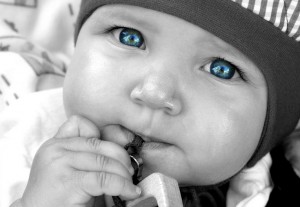
The first IVF baby, Louise Brown, was born on July 25th 1978 at the Oldham General Hospital in Manchester, UK. This technique – in vitro fertilization – involves removing and isolating an egg or eggs from a woman’s body and allowing sperm to fertilize them outside the body (in vitro) in a laboratory. The fertilized egg is then implanted into the woman’s uterus, hopefully resulting in pregnancy.
This technique was pioneered by consultant gynecologist Patrick Steptoe and Cambridge research physiologist Robert Edwards. This was a major stepping stone in the world of reproductive biology, and science as a whole, and since Louise Brown, it is estimated that over five million babies have been born worldwide using this same technique.
Advances in research over the past 10 years
Reproductive Biology and Endocrinology has just published a new series on IVF, showing the advances in research made over the past 10 years.
Antonin Bukovsky and colleagues from the Department of Obstetrics and Gynecology of the University of Tennessee, were vital in showing for the first time that human eggs may develop directly from cultured ovarian surface epithelium (OSE) cells in vitro derived from adult human ovaries, back in 2005. These OSE cells developed into mature eggs in vitro, suitable for fertilization and potential pregnancy.
Further studies this decade went on to analyze the best predictors of success for IVF patients, including endometrial thickness , whether low oxygen culture has an effect on IVF outcome, and how early cleavage may be a better independent marker of implantation potential than zygote morphology – a parameter used regularly in IVF practice today.
Where are we going?
New research is starting to show us where IVF may take us over the next decade. For example, Dr Ashok Agarwal and colleagues discuss in this review how excessive reactive oxygen species (ROS) in vitro leads to oxidative stress conditions for the embryo. This potentially leads to lower fertilization, implantation and pregnancy rates. Potential sources of ROS include exposure to visible light, oxygen concentration, and pH, and need to be studied in more detail over the coming years.
In another study, Deepa Bhartiya and colleagues examined the controversial finding that a novel population of pluripotent stem cells – termed very small embryonic-like stem cells (VSELs) – may serve as an alternative and potential source of egg/sperm derived from the same individual. This could replace the current technique of making gametes from pluripotent stem cells.
New initiatives in the developing world
Infertility levels are not the same around the world. In fact, the overall prevalence of infertility is thought to be 3.5–16.7% in developing countries, compared to 6.9–9.3% in developed countries .
New initiatives looking at low cost assisted reproductive technologies needs to be considered by healthcare professionals and policymakers for these countries, and these are reviewed in this article by Luis Bahamondes and Maria Y Makuch.
Three parent children

Finally, some research on a subject that you may well have seen in the news – so called ‘three parent’ IVF babies. In this article, researchers look at the impact of mitochondrial function of IVF and some of the new treatment possibilities that could help those with mitochondrial dysfunction.
Mitochondria play important roles in oocyte functions and are good indicators of the quality of an oocyte, which in turn is important for fertilization and development into healthy offspring. Quality-compromised oocytes are linked to infertility and developmental disorders.
New technologies have opened up new possibilities for therapeutic advances which will increase the success rates for IVF of oocytes from women with compromised oocyte quality. For example, transference of fully functional mitochondria from other cells into mitochondria-impaired oocytes.
Variations of these current procedures are possible to eliminate transmission of mutant mitochondrial DNA to children, which means that they and in turn their children won’t inherit mitochondrial diseases from their affected parents.
Alana Saarinen,a 13 year old girl, is the result of such a treatment in the USA, with 1% of her DNA coming from a third person mitochondrial donor. However, this treatment is currently prohibited in the USA and the UK and both countries are testing to determine how safe this procedure is in the long term.
This piece released on BBC News Health discusses this in further detail. This technique would be restricted to mitochondrial disease only, with an expert panel suggesting there is no evidence that this procedure is unsafe.
So what’s next?
Further studies will need to be carried out in order to investigate the robustness and reproducibility of these proposed techniques before they become part of regular healthcare.
Will these practices be common practice in years to come? And what will we see another ten years from now? Only time will tell.
If you’re interested in submitting a manuscript to Reproductive Biology and Endocrinology please click here.
———————————————————————————————————————————————
Natasha Salaria is a Journal Development Editor at BioMed Central
One Comment